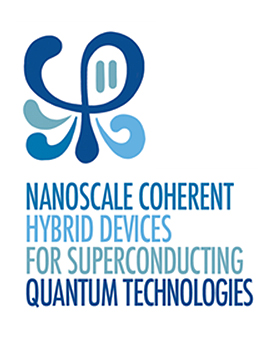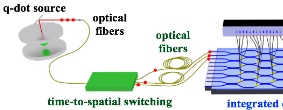iQUTE (Virtuálny výskumný inštitút pre kvantové technológie)
01 January 2019 - Project
European Microkelvin Platform (EMP)
Approved H2020 RIA project (Call H2020-INFRAIA-2018-1, RIA, 2019-2020) for (CLPT) Center of Low Temperature Physics (joint research center of Institue of Experimental Physics of SAS and Faculty of Natural Sciences of Šafárik University, Košice). EMP is a consortium of 17 partners (8 key partners) which have an extensive portfolio of capacities and expertise in ultralow temperature physics. EMP will receive 9.98 M€ (1.1 M€ allocated for CLTP) in the next four years from the European Commisson for supporting user access to its facilities as well as operating and updating the infrastructure. The research activities are dedicated diretly to quantum technologies.
Annotation: The European Microkelvin Platform (EMP) provides access to the ultralow temperature frontier approaching absolute zero. The Platform is continuously evolving by extending its reach, building on the integration achieved through previous infrastructure calls. Europe already has a significant research lead in the microkelvin regime and we will reinforce this by encouraging the further exploitation, in both the shorter and longer term, of ultralow temperatures for the development of new concepts, new applications and new devices, especially in the fields of nanoscience, materials research and quantum technology in all its forms. The EMP is a consortium of 17 partners which provide an extensive portfolio of capacities and expertise in ultralow temperature physics. Since this is a fast evolving and expanding frontier field, we also lay considerable weight on improving and upgrading our infrastructure, since the lowest accessible temperatures are continuously falling. These advances allow us, and our users from across Europe, to study new phenomena, thereby generating new knowledge, applications and commercial opportunities. We have a particular interest in the benefits of ultralow temperature physics for driving forward the inter-related areas of quantum materials, nanoscience, and quantum technology. The activities of the EMP hold enormous potential for innovation. A more extensive description of the Platform and its philosophy can be found in Nature Reviews Materials, The European Microkelvin Platform, Nat. Rev. Mater. 3, 18012 (2018).
Project Duration: 01/01/2019 - 31/12/2022
Project website: http://emplatform.eu/
Project coordinator: Prof. Christian Enss (University of Heidelberg)
15 April 2018 - Project
NATO Science for Peace and Security Programme Secure Communication in the Quantum Era
Acronym: SPS Project Number: G5448
Duration: 2018-2021
This proposal will design, analyze, and implement solutions to securely establish cryptographic keys among a group of participants. We use cryptographic theory to establish structural guarantees at the protocol level and explore performance through implementation on different platforms. Hardness assumptions are chosen to be quantum-safe (based on coding theory or/and lattices). To protect the implementation against manipulation at runtime (e.g., through fault induction), we apply runtime verification. To ensure the necessary capabilities are available, ranging from cryptographic theory to advanced software engineering and signal-level analysis (for hardware implementations), a team of four universities has been formed.
Project coordinator: Prof. Otokar Grošek (FEI STU, Bratislava)
05 April 2018 - Project

COST Action CA16218
Nanoscale coherent hybrid devices for superconducting quantum technologies
Acronym: NANOCOHYBRI
Duration: 01/11/2017-31/10/2021
Superconducting technologies are prime candidates to ripen quantum effects into devices and applications. The accumulated knowledge in decades of work in understanding superconductivity allows scientists now to make experiments by design, controlling relevant parameters in devices. A new field is emerging whose final objective is to improve appliances taking advantage of quantum effects, be it for dissipationless transport of current, generation of high magnetic fields, sensors or quantum information. The field will impact crucial areas for societal development, including energy, transport, medicine or computation. Quantum behavior is controlled by using hybrids of superconductors with magnets, insulators, semiconductors or normal metals. Traditionally, the scientific and technical communities working in superconductivity are spread across projects from different calls, whose activities put Europe at the frontier of research. The present Action aims to address the pressing need for a common place to share knowledge and infrastructure and develop new cooperative projects.
Slovakia MC member: Prof. Peter Samuely (Košice)
01 April 2018 - Project

High dimensional quantum photonic platform
The only successful QuantERA project with Slovak partner HiPhoP has been aproved for financing by the Slovak Academy of Sciences. QuantERA call is understood as the pre-phase of European Quantum Technology Flagship. The project will start on April 1st.
13 March 2018 - Project

COST Action CA15220
Quantum Technologies in Space
Acronym: QTSPACE
Duration: 20/10/2016-19/10/2020
Quantum theory and space science form building blocks of a powerful research framework for exploring the boundaries of modern physics through the unique working conditions offered by experimental tests performed in space. Space-based sources of entangled photons promise the formation of global quantum communicationetworks, long-distance tests of quantum theory and the interplay between relativity and quantum entanglement. Long free-fall times enable high- precision tests of general relativity and tests of the equivalence principle for quantum systems. Harnessing microgravity, high vacuum and low temperature of deep space promises allowing the study of deviations from standard quantum theory for high-mass test particles. Space-based experiments of metrology and sensing will push the precision of clocks, mass detectors and transducers towards the engineering of novel quantum technologies. Our particular contribution is theoretical and covers the following research goals:
- Development of communication protocols over quantum networks,
- Optimization of quantum networks,
- Development of verification and testing algorithms.
Slovakia MC member: Mário Ziman (Bratislava)


